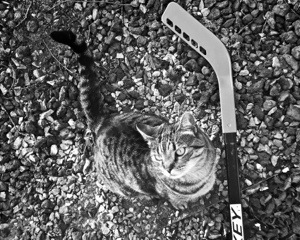Pretty much every morning I check the Google News page, and I generally scroll pretty quickly to the science headlines. Today one of the big headlines was about a fascinating new PLOS ONE study that shows quite conclusively that insects from several orders detect and respond to changes in barometric pressure. Such behavioral reactions in insects make sense as pressure changes usually indicate important changes in the weather that could jeopardize an insect’s reproductive success.
My antennae (no pun intended) immediately popped up because my hazy memory seemed to recall something like this being studied in bark beetles quite some time back. A quick search brought up this 1978 paper. I then went back to the PLOS ONE paper, and thankfully found the authors had cited the older paper in their final reference. The 1978 paper itself cites several other studies dating as far back to 1955 that hint at this kind of phenomenon. My bet is that this general phenomenon was observed prior to 1955, and further digging would take us quite a distance into the past.
The new result is extremely cool, of course. Hopefully it goes some way to reviving an old idea for some new and fruitful study. I don’t fault the study authors for the general tone of the 24 hour news cycle hype that seems to suggest that this is a brand new idea. The media are like that, and once a story gets into the hands of a journalist it can take on a life of its own no matter how careful the interviewed scientist was to state the full case. I suspect that most reporters rarely closely read reference sections.
That said, this little episode started me thinking a bit – with help from a few of my Twitter friends – about how we do science and how much, or how little, we pay attention to the past. Interestingly Chris Buddle at McGill University wrote a very prescient blog post just today that provides a perfect example of what I’m talking about. Specifically, there are certain aspects of the way that science is currently done that cause us to rush forward into the future without paying enough attention to the past.
I can think of three reasons for this, and perhaps you can think of others:
1. The tyranny of high-speed novelty – This comes in at least two flavors, but they’re both mixed into the same underlying ice cream. First, science news, like other news, comes to us from all directions. University communications offices and journal PR departments are eager to capitalize on this for what amounts to free advertising. Although scientists who read these interesting accounts know that science, in general, moves at a modest pace at best, there is likely a subconscious tweak that says “hey, you need to move faster, everyone else is.”
Second, university tenure and promotion committees and granting agencies require ongoing productivity. This makes sense, of course. But the main measure of productivity is the peer reviewed paper. This means that there are likely many papers that escape into the wild from the lab or field before their results are fully mature. Contrast this to, for instance, Charles Darwin who spent years studying barnacles to the point where he wrote in a letter:
I am at work on the second vol. of the Cirripedia, of which creatures I am wonderfully tired: I hate a Barnacle as no man ever did before, not even a Sailor in a slow-sailing ship. My first vol. is out: the only part worth looking at is on the sexes of Ibla & Scalpellum; I hope by next summer to have done with my tedious work.
This type of longterm commitment to a study still happens today, but often in special circumstances. Besides the fact that getting funding for Darwin-style barnacle research these days would be woefully difficult, proposing to conduct such a long study with no predetermined timeline or outcome would sink any proposal.
So there are career pressures on one side that push scientists into grant-cycle-length (or shorter) studies, and there is the constant barrage of news stories and CSI-like shows on the other other side that give the impression to the public that science moves at a furious pace. Both together add up to at least some degree of myopia across the board.
2. Referencing software – In this case I’m talking about products like EndNote and RefWorks and others that are very useful, but also potentially damaging in the development of a good vision of the past. To this day I still do all of my reference work in papers that I write or edit without these tools. I have tried various software solutions in the past, but I have found that they tend to distance me from the literature and dull my ability to remember what has been done before.
When I physically type in a reference, or even copy-and-patse a citation from a previous paper and revise to fit the journal standard, it forces me to think about that paper and the foundation on which it was built. This often leads me down a reference rabbit trail that can, on occasion, help me to contemplate the topic in a deeper manner. If, on the other hand, I simply input “(Smith et al. 1997)” and the software does the rest, my brain just carries on with what it’s doing and doesn’t necessarily make any new connections. The writing process should inherently be a learning process, and by letting software do parts of the work for us, I fear that one part of that process is going by the wayside.
3. Online access – At this point I’m going to start to sound a bit like this guy, so please just roll your eyes for a moment and then hear me out. First, note that I think that the fact that much of the scientific literature in the world is now online is a great thing. Even better is the fact that a lot of it is either open access or is heading that way.
Now here’s the part where I will start to sound old. When I started my Ph.D. in 1995, the internet as we know it today had just barely gotten off of the ground. Prior to that I had been using things like GOPHER, ELM, and PINE… many of you probably have no clue what I’m even talking about here. The long and short of it was that virtually all scholarly outputs were on paper in the library. When I was researching a subject, I would go to the library, use an index based on a mainframe (or even extensive tomes of the paper version of Biological Abstracts), and then get a rolling cart that I’d push around the library. My cart and I would head through the stacks, picking up volumes along the way. Then I’d go to the central photocopying area to copy the articles that I wanted to read. Later, back at my desk or lab bench I’d read the articles and circle any references that I needed in order to delve back further into the literature. Then I’d make my way back to the library and restart the process. Chasing references was a process that took time and allowed for thought.
Today I fire up my web browser, point it at Google Scholar, do a few quick searches, and then I’m off to the races. If, while I’m reading a paper, I see a reference that interests me, there’s usually a hyperlink there to take me right to that paper. Within minutes my virtual desktop can be full of PDFs, enough to keep me busy reading for weeks. Reference chasing now takes no time at all.
The problem with the old process was that it was painfully slow and labor intensive. The problem with the new process is that those silicon brains are so fast that they don’t allow time for our human brains to stop to really think. In 1998, when I was standing by the photocopier, I was also mulling over the papers that were dropping into the copier tray. The process forced the time to think on me because I really couldn’t go anywhere else while the copier was doing its job or while I was wandering through the stacks. In 2013 the process should provide me with more time to think because it is a lot faster. But that extra time does not necessarily get filled with contemplation unless I make it so. And there are many pressures – and temptations – that all of us face that can easily reduce that technologically found time into lost time in no time.
It should also be noted that while there used to be a “demographic” gap in the papers that were online, most journals have now archived almost their entire collection (e.g., a shameless plug for a fine journal here). This is to our benefit, if we take advantage of it.
_____
So what can be done about this? There is not much that we can immediately do about media, administration, granting agency, or public expectations and perception because these are all an ingrained part of the current culture. Cultural shifts take time.
The challenge to scientists, then, is to work to change that culture, one researcher and one act at a time. I am not blaming referencing software or online journals. Far from it. Both are vital parts of the process in our era, and both bring benefits that were hardly imagined a couple of decades ago. But with this technology comes a responsibility to ensure that we are doing things like undertaking longterm studies; reading deeply into the literature; spending time contemplating instead of getting caught up in a Red Queen scenario; making sure that both our students and ourselves understand and explore the deep foundations of current breakthroughs; and doing our level best to get it across to the media that our results are only possible because of work that has been done by others.
We owe it to our students, to the public, to our scientific “ancestors,” to our current colleagues, and to ourselves.

